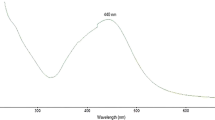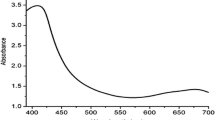Abstract
Plant-extract mediated nanoparticles synthesis is a viable alternative to chemical reduction techniques. Here, we report the microwave-assisted rapid synthesis of silver and gold nanoparticles by the phytoreducer Stereospermum suaveolens for the first time. The formation of the nascent silver and gold nanoparticles is confirmed by their intense surface plasmon resonance peaks at 431 and 585 nm in UV–visible spectroscopy. The poly phenolic and alcoholic functional groups present in the aqueous root bark extract that performed the bioreduction processes have been detected using Fourier transform infrared spectroscopy. Powder X-ray diffraction and selected area electron diffraction patterns settled face centered cubic crystal structures to both silver and gold nanoparticles with a preferred orientation towards the (111) plane. Transmission electron microscopic analysis proved more or less spherical geometry of the silver and gold nanoparticles with average diameter of 49.77 ± 11.64 and 27.19 ± 5.96 nm, respectively. The nanoparticles showed excellent free-radical scavenging activity than the root bark extract Stereospermum suaveolens and the IC50 values obtained were 108.36 ± 1.62, 45.59 ± 0.18, 34.53 ± 0.31 µg/mL, respectively, for the extract, gold and silver nanoparticles. The metal nanoparticles have accomplished good antimicrobial properties towards bacterial and fungal pathogens and were demonstrated herein. The antiproliferative effects of the synthesized silver and gold nanoparticles on human lung adenocarcinoma cells A549 were studied using the MTT assay and the obtained IC50 values 33.81 ± 0.72 and 52.97 ± 0.73 µg/mL lies in the clinical range.
Graphical Abstract













Similar content being viewed by others
References
Kim D-Y, Kim M, Shinde S et al (2017) Cytotoxicity and antibacterial assessment of gallic acid capped gold nanoparticles. Colloids Surfaces B Biointerfaces 149:162–167. https://doi.org/10.1016/j.colsurfb.2016.10.017
Rajan R, Chandran K, Harper SL et al (2015) Plant extract synthesized silver nanoparticles: an ongoing source of novel biocompatible materials. Ind Crops Prod 70:356–373. https://doi.org/10.1016/j.indcrop.2015.03.015
Mehmood A, Murtaza G, Bhatti TM, Kausar R (2017) Phyto-mediated synthesis of silver nanoparticles from Melia azedarach L. leaf extract: characterization and antibacterial activity. Arab J Chem 10:S3048–S3053. https://doi.org/10.1016/j.arabjc.2013.11.046
Jeeva K, Thiyagarajan M, Elangovan V et al (2014) Caesalpinia coriaria leaf extracts mediated biosynthesis of metallic silver nanoparticles and their antibacterial activity against clinically isolated pathogens. Ind Crops Prod 52:714–720. https://doi.org/10.1016/j.indcrop.2013.11.037
Soshnikova V, Kim YJ, Singh P et al (2017) Cardamom fruits as a green resource for facile synthesis of gold and silver nanoparticles and their biological applications. Artif Cells Nanomed Biotechnol. https://doi.org/10.1080/21691401.2017.1296849
Sperling RA, Rivera Gil P, Zhang F et al (2008) Biological applications of gold nanoparticles. Chem Soc Rev 37:1896. https://doi.org/10.1039/b712170a
Singh AK, Tiwari R, Kumar V et al (2017) Photo-induced biosynthesis of silver nanoparticles from aqueous extract of Dunaliella salina and their anticancer potential. J Photochem Photobiol B Biol 166:202–211. https://doi.org/10.1016/j.jphotobiol.2016.11.020
Noruzi M (2015) Biosynthesis of gold nanoparticles using plant extracts. Bioprocess Biosyst Eng 38:1–14. https://doi.org/10.1007/s00449-014-1251-0
Krishnaswamy K, Orsat V (2015) Insight into the nanodielectric properties of gold nanoparticles synthesized from maple leaf and pine needle extracts. Ind Crops Prod 66:131–136. https://doi.org/10.1016/j.indcrop.2014.12.048
Dutta PP, Bordoloi M, Gogoi K et al (2017) Antimalarial silver and gold nanoparticles: green synthesis, characterization and in vitro study. Biomed Pharmacother 91:567–580. https://doi.org/10.1016/j.biopha.2017.04.032
Barabadi H, Honary S, Ali Mohammadi M et al (2017) Green chemical synthesis of gold nanoparticles by using Penicillium aculeatum and their scolicidal activity against hydatid cyst protoscolices of Echinococcus granulosus. Environ Sci Pollut Res. https://doi.org/10.1007/s11356-016-8291-8
Suriyakalaa U, Antony JJ, Suganya S et al (2013) Hepatocurative activity of biosynthesized silver nanoparticles fabricated using Andrographis paniculata. Colloids Surfaces B Biointerfaces 102:189–194. https://doi.org/10.1016/j.colsurfb.2012.06.039
Ajitha B, Reddy YAK, Reddy PS et al (2016) Instant biosynthesis of silver nanoparticles using Lawsonia inermis leaf extract: innate catalytic, antimicrobial and antioxidant activities. J Mol Liq 219:474–481. https://doi.org/10.1016/j.molliq.2016.03.041
Srivastava N, Khatoon S, Rawat AKS et al (2009) Chromatographic estimation of p-coumaric acid and triacontanol in an ayurvedic root drug patala (Stereospermum suaveolens Roxb.). J Chromatogr Sci 47:936–939
Yunpu W, Leilei D, Liangliang F et al (2016) Review of microwave-assisted lignin conversion for renewable fuels and chemicals. J Anal Appl Pyrolysis 119:104–113. https://doi.org/10.1016/j.jaap.2016.03.011
Francis S, Joseph S, Koshy EP, Mathew B (2017) Green synthesis and characterization of gold and silver nanoparticles using Mussaenda glabrata leaf extract and their environmental applications to dye degradation. Environ Sci Pollut Res. https://doi.org/10.1007/s11356-017-9329-2
Chang S-T, Wu J-H, Wang S-Y et al (2001) Antioxidant activity of extracts from Acacia confusa bark and heartwood. J Agric Food Chem 49:3420–3424. https://doi.org/10.1021/jf0100907
Rathi Sre PR, Reka M, Poovazhagi R et al (2015) Antibacterial and cytotoxic effect of biologically synthesized silver nanoparticles using aqueous root extract of Erythrina indica lam. Spectrochim Acta Part A Mol Biomol Spectrosc 135:1137–1144. https://doi.org/10.1016/j.saa.2014.08.019
Swarnavalli GCJ, Dinakaran S, Raman N et al (2015) Bio inspired synthesis of monodispersed silver nano particles using Sapindus emarginatus pericarp extract—study of antibacterial efficacy. J Saudi Chem Soc. https://doi.org/10.1016/j.jscs.2015.03.004
Talarico LB, Zibetti RG, Faria PC et al (2004) Anti-herpes simplex virus activity of sulfated galactans from the red seaweeds Gymnogongrus griffithsiae and Cryptonemia crenulata. Int J Biol Macromol 34:63–71. https://doi.org/10.1016/j.ijbiomac.2004.03.002
Mata R, Nakkala JR, Sadras SR (2015) Biogenic silver nanoparticles from Abutilon indicum: their antioxidant, antibacterial and cytotoxic effects in vitro. Colloids Surfaces B Biointerfaces 128:276–286. https://doi.org/10.1016/j.colsurfb.2015.01.052
Joseph S, Mathew B (2015) Microwave-assisted green synthesis of silver nanoparticles and the study on catalytic activity in the degradation of dyes. J Mol Liq 204:184–191. https://doi.org/10.1016/j.molliq.2015.01.027
Francis S, Joseph S, Koshy EP, Mathew B (2017) Synthesis and characterization of multifunctional gold and silver nanoparticles using leaf extract of Naregamia alata and their applications to catalysis and control of mastitis. New J Chem. https://doi.org/10.1039/c7nj02453c
Slistan-Grijalva A, Herrera-Urbina R, Rivas-Silva JF et al (2005) Classical theoretical characterization of the surface plasmon absorption band for silver spherical nanoparticles suspended in water and ethylene glycol. 27:104–112 https://doi.org/10.1016/j.physe.2004.10.014
Francis S, Joseph S, Koshy EP, Mathew B (2017) Microwave assisted green synthesis of silver nanoparticles using leaf extract of Elephantopus scaber and its environmental and biological applications. Artif Cells Nanomed Biotechnol. https://doi.org/10.1080/21691401.2017.1345921
Joseph S, Mathew B (2014) Microwave-assisted facile synthesis of silver nanoparticles in aqueous medium and investigation of their catalytic and antibacterial activities. J Mol Liq 197:346–352. https://doi.org/10.1016/j.molliq.2014.06.008
Sujitha MV, Kannan S (2013) Green synthesis of gold nanoparticles using Citrus fruits (Citrus limon, Citrus reticulata and Citrus sinensis) aqueous extract and its characterization. Spectrochim Acta Part A Mol Biomol Spectrosc 102:15–23. https://doi.org/10.1016/j.saa.2012.09.042
Jebakumar Immanuel Edison TN, Sethuraman MG (2013) Electrocatalytic reduction of benzyl chloride by green synthesized silver nanoparticles using pod extract of Acacia nilotica. ACS Sustain Chem Eng 1:1326–1332. https://doi.org/10.1021/sc4001725
Banala RR, Nagati VB, Karnati PR (2015) Green synthesis and characterization of Carica papaya leaf extract coated silver nanoparticles through X-ray diffraction, electron microscopy and evaluation of bactericidal properties. Saudi J Biol Sci 22:637–644. https://doi.org/10.1016/j.sjbs.2015.01.007
Vijayan R, Joseph S, Mathew B (2017) Green synthesis, characterization and applications of noble metal nanoparticles using Myxopyrum serratulum A. W. Hill leaf extract. Bionanoscience. https://doi.org/10.1007/s12668-017-0433-z
Dwivedi AD, Gopal K (2010) Biosynthesis of silver and gold nanoparticles using Chenopodium album leaf extract. Colloids Surfaces A Physicochem Eng Asp 369:27–33. https://doi.org/10.1016/j.colsurfa.2010.07.020
Raja S, Ramesh V, Thivaharan V (2017) Green biosynthesis of silver nanoparticles using Calliandra haematocephala leaf extract, their antibacterial activity and hydrogen peroxide sensing capability. Arab J Chem 10:253–261. https://doi.org/10.1016/j.arabjc.2015.06.023
Kalishwaralal K, Deepak V, Ram Kumar Pandian S et al (2010) Biosynthesis of silver and gold nanoparticles using Brevibacterium casei. Colloids Surfaces B Biointerfaces 77:257–262. https://doi.org/10.1016/j.colsurfb.2010.02.007
Sankar R, Karthik A, Prabu A et al (2013) Origanum vulgare mediated biosynthesis of silver nanoparticles for its antibacterial and anticancer activity. Colloids Surfaces B Biointerfaces 108:80–84. https://doi.org/10.1016/j.colsurfb.2013.02.033
Borchert H, Shevchenko EV, Robert A et al (2005) Determination of nanocrystal sizes: a comparison of TEM, SAXS, and XRD studies of highly monodisperse CoPt3 particles. Langmuir 21:1931–1936. https://doi.org/10.1021/la0477183
Dubey SP, Lahtinen M, Sillanpää M (2010) Tansy fruit mediated greener synthesis of silver and gold nanoparticles. Process Biochem 45:1065–1071. https://doi.org/10.1016/j.procbio.2010.03.024
Chopade BA, Salunke GR, Ghosh S et al (2014) Rapid efficient synthesis and characterization of silver, gold, and bimetallic nanoparticles from the medicinal plant Plumbago zeylanica and their application in biofilm control. Int J Nanomed 9:2635–2653. https://doi.org/10.2147/IJN.S59834
Choi CW, Kim SC, Hwang SS et al (2002) Antioxidant activity and free radical scavenging capacity between Korean medicinal plants and flavonoids by assay-guided comparison. Plant Sci 163:1161–1168. https://doi.org/10.1016/S0168-9452(02)00332-1
Ramamurthy CH, Padma M, mariya samadanam ID et al (2013) The extra cellular synthesis of gold and silver nanoparticles and their free radical scavenging and antibacterial properties. Colloids Surfaces B Biointerfaces 102:808–815. https://doi.org/10.1016/j.colsurfb.2012.09.025
Kalpanadevi V, Mohan VR (2012) In vitro antioxidant studies of Begonia malabarica Lam. and Begonia floccifera Bedd. Asian Pac J Trop Biomed 2:S1572–S1577. https://doi.org/10.1016/S2221-1691(12)60455-9
Krishnaiah D, Bono A, Sarbatly R, Anisuzzaman SM (2015) Antioxidant activity and total phenolic content of an isolated Morinda citrifolia L. methanolic extract from Poly-ethersulphone (PES) membrane separator. J King Saud Univ Eng Sci 27:63–67. https://doi.org/10.1016/j.jksues.2013.01.002
Nazeruddin GM, Prasad NR, Prasad SR et al (2014) Coriandrum sativum seed extract assisted in situ green synthesis of silver nanoparticle and its anti-microbial activity. Ind Crops Prod 60:212–216. https://doi.org/10.1016/j.indcrop.2014.05.040
Singh R, Shedbalkar UU, Wadhwani SA, Chopade BA (2015) Bacteriagenic silver nanoparticles: synthesis, mechanism, and applications. Appl Microbiol Biotechnol 99:4579–4593. https://doi.org/10.1007/s00253-015-6622-1
Phull A-R, Abbas Q, Ali A et al (2016) Antioxidant, cytotoxic and antimicrobial activities of green synthesized silver nanoparticles from crude extract of Bergenia ciliata. Futur J Pharm Sci 2:31–36. https://doi.org/10.1016/j.fjps.2016.03.001
Geethalakshmi R, Sarada DVL (2013) Characterization and antimicrobial activity of gold and silver nanoparticles synthesized using saponin isolated from Trianthema decandra L. Ind Crops Prod 51:107–115. https://doi.org/10.1016/j.indcrop.2013.08.055
Balouiri M, Sadiki M, Ibnsouda SK (2016) Methods for in vitro evaluating antimicrobial activity: a review. J Pharm Anal 6:71–79. https://doi.org/10.1016/j.jpha.2015.11.005
Lokina S, Stephen A, Kaviyarasan V et al (2014) Cytotoxicity and antimicrobial activities of green synthesized silver nanoparticles. Eur J Med Chem 76:256–263. https://doi.org/10.1016/j.ejmech.2014.02.010
Nakkala JR, Mata R, Bhagat E, Sadras SR (2015) Green synthesis of silver and gold nanoparticles from Gymnema sylvestre leaf extract: study of antioxidant and anticancer activities. J Nanoparticle Res. https://doi.org/10.1007/s11051-015-2957-x
Patil MP, Kim G-D (2017) Eco-friendly approach for nanoparticles synthesis and mechanism behind antibacterial activity of silver and anticancer activity of gold nanoparticles. Appl Microbiol Biotechnol 101:79–92. https://doi.org/10.1007/s00253-016-8012-8
Rajan A, Vilas V, Philip D (2015) Studies on catalytic, antioxidant, antibacterial and anticancer activities of biogenic gold nanoparticles. J Mol Liq 212:331–339. https://doi.org/10.1016/j.molliq.2015.09.013
Naraginti S, Li Y (2017) Preliminary investigation of catalytic, antioxidant, anticancer and bactericidal activity of green synthesized silver and gold nanoparticles using Actinidia deliciosa. J Photochem Photobiol B Biol 170:225–234. https://doi.org/10.1016/j.jphotobiol.2017.03.023
Raghunandan D, Ravishankar B, Sharanbasava G et al (2011) Anti-cancer studies of noble metal nanoparticles synthesized using different plant extracts. Cancer Nanotechnol 2:57–65. https://doi.org/10.1007/s12645-011-0014-8
Acknowledgements
Authors gratefully acknowledge the University Grants Commission, Government of India for financial assistance to Sijo Francis under FDP plan of UGC.
Author information
Authors and Affiliations
Corresponding author
Ethics declarations
Disclosure statement
Authors unanimously publish this article and they only are responsible for the content and the write-up of the same.
Rights and permissions
About this article
Cite this article
Francis, S., Koshy, E.P. & Mathew, B. Green synthesis of Stereospermum suaveolens capped silver and gold nanoparticles and assessment of their innate antioxidant, antimicrobial and antiproliferative activities. Bioprocess Biosyst Eng 41, 939–951 (2018). https://doi.org/10.1007/s00449-018-1925-0
Received:
Accepted:
Published:
Issue Date:
DOI: https://doi.org/10.1007/s00449-018-1925-0




